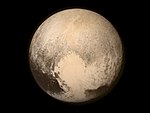astro.wikisort.org - Asteroid
(523775) 2014 YB35, provisional designation 2014 YB35, is a stony near-Earth object and potentially hazardous asteroid of the Apollo group, approximately 300 meters (980 feet) in diameter. It was discovered on 27 December 2014 by the Catalina Sky Survey at the Catalina Station in Arizona, United States.[1] In March 2015, a minor-planet moon, less than half the size of its primary, was discovered by radar astronomers at Goldstone Observatory.[3] The primary body of the binary system has a rotation period of 3.3 hours, while the secondary's orbital period remains unknown.[8]
| Discovery[1] | |
|---|---|
| Discovered by | Catalina Sky Survey |
| Discovery site | Catalina Station |
| Discovery date | 27 December 2014 |
| Designations | |
MPC designation | (523775) 2014 YB35 |
Alternative designations | 2014 YB35 |
Minor planet category | Apollo · NEO · PHA[1][2] |
| Orbital characteristics[2] | |
| Epoch 27 April 2019 (JD 2458600.5) | |
| Uncertainty parameter 1 | |
| Observation arc | 3.72 yr (1,360 d) |
| Aphelion | 2.7834 AU |
| Perihelion | 0.9697 AU |
Semi-major axis | 1.8766 AU |
| Eccentricity | 0.4833 |
Orbital period (sidereal) | 2.57 yr (939 d) |
Mean anomaly | 209.73° |
Mean motion | 0° 23m 0.24s / day |
| Inclination | 12.641° |
Longitude of ascending node | 3.7634° |
Argument of perihelion | 188.63° |
| Known satellites | 1 (D: <150 m; P: n.a.)[3][4][5] |
| Earth MOID | 0.0224 AU (8.73 LD) |
| Physical characteristics | |
Mean diameter | 0.300 km[3][4][5] 0.52 km[6] |
Synodic rotation period | 3.277±0.002 h[7][lower-alpha 1] |
Geometric albedo | 0.20 (assumed)[8] 0.39[5] |
Spectral type | S (assumed)[8] |
Absolute magnitude (H) | 19.0[1][2][6] 20.0[8] |
Orbit and classification
2014 YB35 is a member of the Apollo asteroids, a group of near-Earth object with an Earth-crossing orbit. It orbits the Sun at a distance of 1.0–2.8 AU once every 2 years and 7 months (939 days; semi-major axis of 1.88 AU). Its orbit has an eccentricity of 0.48 and an inclination of 13° with respect to the ecliptic.[2] The body's observation arc begins at with its official discovery observation at Catalina Station in December 2014.[1]
Close encounters
It passed by Earth on 27 March 2015 at 06:21 UTC at a distance of 4,473,807 ± 155 km (2,779,895 ± 96 mi), or 11.7 lunar distances, and a relative speed of 10.16 km/s (6.31 mi/s).[2] 2014 YB35's next encounter with Earth will be in 2033, at a distance of approximately 3,330,000 km (2,070,000 mi).[2]
Satellite
The Goldstone Deep Space Communications Complex was scheduled to observe this object on 20 March 2015, at which time it was expected they could obtain coarse radar images and continuous wave spectra, which may help determine the asteroid's composition.[6] These observations showed a small companion less than 150 meters across orbiting the asteroid, with an unknown orbit.[3][4]
Numbering and naming
This minor planet was numbered by the Minor Planet Center on 25 September 2018 (M.P.C. 111778).[9] As of 2018, it has not been named.[1]
See also
- List of asteroid close approaches to Earth in 2015
Notes
- Lightcurve plot of (523775) 2014 YB35 by Robert Stephens. Rotation period 3.277±0.002 hours with a brightness amplitude of mag. Quality code is 2+. Summary figures for at the LCDB and CS3
References
- "523775 (2014 YB35)". Minor Planet Center. Retrieved 9 October 2018.
- "JPL Small-Body Database Browser: 523775 (2014 YB35)" (2018-09-17 last obs.). Jet Propulsion Laboratory. Retrieved 9 October 2018.
- Johnston, Wm. Robert (30 September 2018). "Asteroids with Satellites Database – (450894) 2008 BT18". Johnston's Archive. Retrieved 9 October 2018.
- Naidu, S. P.; Benner, L. A. M.; Brozovic, M.; Giorgini, J. D.; Jao, J. S.; Lee, C. G.; et al. (July 2015). "2014 YB_35". Central Bureau Electronic Telegrams. 4121 (4121). 1. Bibcode:2015CBET.4121....1N.
- "Asteroid (523775) 2014 YB35". Small Bodies Data Ferret. Retrieved 9 October 2018.
- Benner, Lance A. M. (4 March 2015). "Goldstone Radar Observations Planning: 2002 FG7 and 2014 YB35". NASA/Jet Propulsion Laboratory. Archived from the original on 27 March 2015. Retrieved 13 March 2015. (L. Benner's list of radiometric NEA observations)
- Stephens, Robert D.; French, Linda M.; Warner, Brian D.; Connour, Kyle (October 2015). "Lightcurve Analysis of Two Near-Earth Asteroids". The Minor Planet Bulletin. 42 (4): 276–277. Bibcode:2015MPBu...42..276S. ISSN 1052-8091.
- "LCDB Data for (523775)". Asteroid Lightcurve Database (LCDB). Retrieved 9 October 2018.
- "MPC/MPO/MPS Archive". Minor Planet Center. Retrieved 9 October 2018.
External links
- MPEC 2014-Y89: 2014 YB35, Minor Planet Electronic Circular at the IAU Minor Planet Center
- Asteroids with Satellites at Johnstonsarchive.net
- Binary and Ternary Near-Earth Asteroids Detected by Radar by the Jet Propulsion Laboratory
- 2014 YB35 at the IAU Minor Planet Center
- (523775) 2014 YB35 at NeoDyS-2, Near Earth Objects—Dynamic Site
- Ephemeris · Obs prediction · Orbital info · MOID · Proper elements · Obs info · Close · Physical info · NEOCC
- YB35 (523775) 2014 YB35 at ESA–space situational awareness
- (523775) 2014 YB35 at the JPL Small-Body Database
На других языках
[de] (523775) 2014 YB35
(523775) 2014 YB35, Alternativschreibweise 2014 YB35, ist ein Erdnaher Asteroid der Apollo-Gruppe. Er wurde durch die Catalina Sky Survey am 27. Dezember 2014 entdeckt. Er hat einen Durchmesser von etwa 520 Metern und gilt als potentiell gefährlicher Asteroid (potentially hazardous asteroid, kurz PHA).[1]- [en] (523775) 2014 YB35
Другой контент может иметь иную лицензию. Перед использованием материалов сайта WikiSort.org внимательно изучите правила лицензирования конкретных элементов наполнения сайта.
WikiSort.org - проект по пересортировке и дополнению контента Википедии


